
The southern platyfish, common platy, or moonfish is a species of freshwater fish in family Poeciliidae of order Cyprinodontiformes. A live-bearer, it is closely related to the green swordtail and can interbreed with it. It is native to an area of North and Central America stretching from Veracruz, Mexico, to northern Belize.

Gymnophthalmidae is a family of lizards with at least 250 species, sometimes known commonly as spectacled lizards or microteiids. They are called "spectacled" because of their transparent lower eyelids, which allow them to still see with closed eyes. As in most lizards, except geckos, these eyelids are movable. The Alopoglossidae have been recently moved from this family.
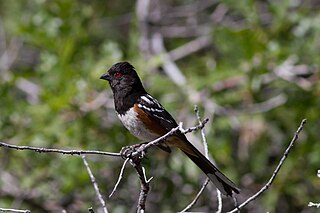
The spotted towhee is a large New World sparrow. The taxonomy of the towhees has been debated in recent decades, and until 1995 this bird and the eastern towhee were considered a single species, the rufous-sided towhee. Another outdated name for the spotted towhee is the Oregon towhee. The call may be harsher and more varied than for the eastern towhee.
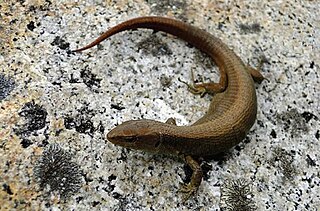
Euspondylus is a genus of lizards in the family Gymnophthalmidae.

Prionodactylus is a former genus of lizards in the family Gymnophthalmidae. Species that at least at some point have been placed in the genus are reassigned to Arthrosaura, Cercosaura, Echinosaura, Pholidobolus, Placosoma, Proctoporus, Ptychoglossus, and Riolama.
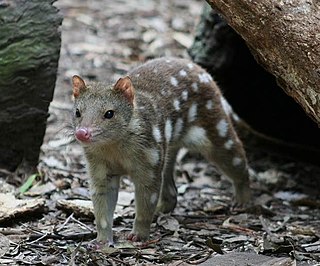
The tiger quoll, also known as the spotted-tailed quoll, spotted quoll, spotted-tailed dasyure, or tiger cat, is a carnivorous marsupial of the quoll genus Dasyurus native to Australia. With males and females weighing around 3.5 and 1.8 kg, respectively, it is the world's second-largest extant carnivorous marsupial, behind the Tasmanian devil. Two subspecies are recognised; the nominate is found in wet forests of southeastern Australia and Tasmania, and a northern subspecies, D. m. gracilis, is found in a small area of northern Queensland and is endangered.

Dermestidae are a family of Coleoptera that are commonly referred to as skin beetles. Other common names include larder beetle, hide or leather beetles, carpet beetles, and khapra beetles. There are over 1,800 species described.
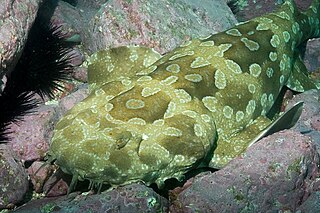
The spotted wobbegong is a carpet shark in the family Orectolobidae, endemic to Australia. It is a large, robust species, typically reaching 150–180 centimetres (59–71 in) in length. Coloured green, yellow, or brown, it has distinctive O-shaped spots throughout its body. It is nocturnal, resting at day and feeding on fish and invertebrates at night. An ovoviviparous species, the spotted wobbegong gives birth in the spring, during which time males can act aggressively towards other males and females. It has been known to bite humans, sometimes unprovoked, which can produce severe wounds. The species is fished commercially in Australia, but it is not severely threatened. It is listed as a least-concern species on the IUCN Red List.

The narrowtail catshark is a catshark of the family Scyliorhinidae, found off the coasts of Honduras and Nicaragua, between latitudes 18° N and 10° N, at depths between 190 and 410 m. It can grow up to a length of 35 cm (14 in). The reproduction of this catshark is oviparous.
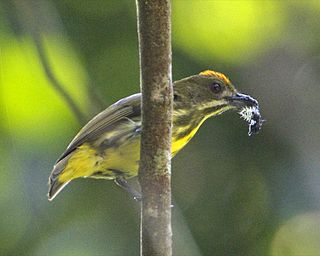
The yellow-breasted flowerpecker is a species of bird in the family Dicaeidae. It is found in Brunei, Indonesia, Malaysia, Myanmar, Singapore, and Thailand. Its natural habitats are subtropical or tropical moist lowland forest and subtropical or tropical moist montane forest.
Cercosaura phelpsorum is a species of lizard in the family Gymnophthalmidae. The species is endemic to Venezuela.
Euspondylus acutirostris, the sharp-snouted sun tegus, is a species of lizard in the family Gymnophthalmidae. It is endemic to Venezuela.
Euspondylus auyanensis is a species of lizard in the family Gymnophthalmidae. It is endemic to Venezuela.
Euspondylus caideni is a species of lizard in the family Gymnophthalmidae. The species is endemic to Peru.
Euspondylus excelsum is a species of lizard in the family Gymnophthalmidae. It is endemic to Peru.
Euspondylus guentheri, also known commonly as Günther's sun tegu, is a species of lizard in the family Gymnophthalmidae. The species is native to Ecuador, and has also been reported from Peru. It lives in lowland tropical and subtropical forest habitats. The specific epithet guentheri is in honour of Albert Günther, a German-born British zoologist. E. guentheri is mostly diurnal, spending time in low branches or basking on the ground. If threatened, it will run for cover.
Euspondylus monsfumus is a species of lizard in the family Gymnophthalmidae. It is endemic to Venezuela.
Euspondylus nellycarrillae is a species of lizard in the family Gymnophthalmidae. It is endemic to Peru.
Euspondylus paxcorpus is a species of lizard in the family Gymnophthalmidae. It is endemic to Peru.
Proctoporus rahmi, Rahm's sun tegu, is a species of lizard in the family Gymnophthalmidae. It is endemic to Peru.









